So, what are we to make of the dissenting opinions in Whole Woman’s Health? In an email to those of us participating in this discussion, the Honorable Judge Richard Posner was brief and to the point: “The length, tedium, nitpicking, unreality, and fussy formalism of the dissenting opinions make those opinions a remarkable throwback to the nineteenth century.”
Not having a life-tenured appointment to the federal judiciary, I will write at a bit greater length and with more circumspection.
Justice Clarence Thomas, writing for himself, makes the complaint that “today’s decision requires courts to ‘consider the burdens a law imposes on abortion access together with the benefits those laws confer.’ ” You probably stopped to re-read that sentence. But you were right the first time. Thomas is actually complaining that the court’s majority considers the burdens and the benefits together. And he believes that is a bad thing.
Here is what that is about. In deciding whether a restriction on abortion is an “undue burden” on a woman’s ability to effectuate her own decision, those defending such restrictions argue that “undue” and “burden” are separate considerations. In assessing how great the burden is on women, that is, they argue a court should not consider how flimsy the state’s health justification might be. The majority rejects that bifurcation and argues that any purported shortcomings in the clinics’ proof of burden on women is negligible given the absence of any real showing that the restrictions actually advance any state health justifications. Posner put it well in his opinion in Planned Parenthood v. Schimel:
If a burden significantly exceeds what is necessary to advance the state’s interests, it is “undue,” … which is to say unconstitutional. The feebler the medical grounds (in this case, they are nonexistent), the likelier is the burden on the right to abortion to be disproportionate to the benefits and therefore excessive.
Thomas’ dissenting opinion in Whole Woman’s Health suggests that one need not consider how flimsy the state’s justification is for its restrictions. As long as some sufficient number of women can manage to overcome the obstacle, it matters not, they argue, whether there is an actual medical justification. University of Maryland School of Law professor Mark Graber, writing on Balkinization, has the perfect response:
Readers of [the dissenting] opinions might think those justices would sustain a facial challenge to a regulation requiring woman seeking abortions to first read the entire text of Les Miserables on the ground that a reasonable percentage of women have either read that text or could do so in two-three days of uninterrupted reading.
The dissenting position thus can’t be right. This one issue serves to illustrate the degree to which the dissenting opinions use every legal bit of “legalistic argle bargle” (to appropriate Justice Antonin Scalia’s memorable phrase) to evade confronting the fundamental fact that the Texas law was designed purely and simply to place obstacles in the path of women seeking abortions.
In suggesting that the burden on women isn’t great in his own dissent, Justice Samuel Alito argues that “virtually no woman of reproductive age lives more than 150 miles from an open clinic.” For this proposition he cites evidence that “82.5 [percent] of Texas women of reproductive age live within 150 miles of open clinics in Austin, Dallas, Fort Worth, Houston, and San Antonio.” What that means is that 17.5 percent of those women do live more than 150 miles from an open clinic. That is almost 1 in 5 women. One in 5 women of reproductive age, in the dissent’s view, is the same as “virtually no woman of reproductive age.”
There is one part of the dissent of Thomas for which reproductive rights litigators should be grateful. He states that the majority’s undue burden test looks like “the strict-scrutiny standard that Casey rejected, under which only the most compelling rationales justified restrictions on abortion.”
“The State’s burden,” he concludes, “has been ratcheted to a level that has not been applied for a quarter century.” He may be right. Let’s hope so.
